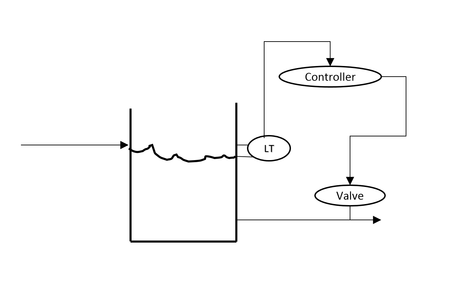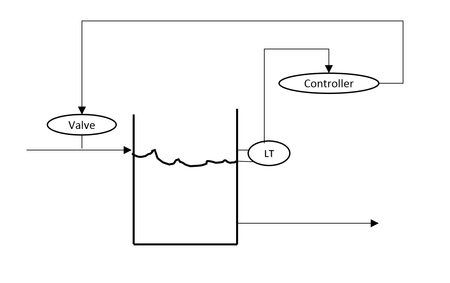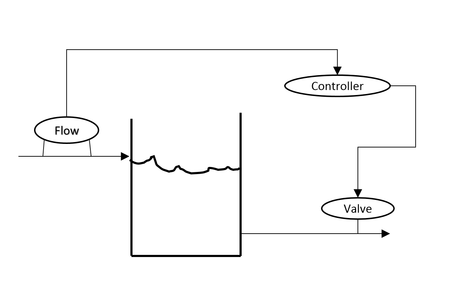Process controls: Difference between revisions
No edit summary |
No edit summary |
||
| Line 33: | Line 33: | ||
Feedback control refers to a system where the controlled variable is measured while the manipulated variable is changed. Due to the delayed nature of the control scheme, a disadvantage is that the system is almost always wrong before any corrective measures are taken. However, since the output is measured directly, an accurate depiction of the output is known at all times. |
Feedback control refers to a system where the controlled variable is measured while the manipulated variable is changed. Due to the delayed nature of the control scheme, a disadvantage is that the system is almost always wrong before any corrective measures are taken. However, since the output is measured directly, an accurate depiction of the output is known at all times. |
||
===Case 1=== |
===Case Study 1=== |
||
[[File:Feedback Control1.png|thumb|center|'''Figure 1''' Feedback Control Scheme (1)|450x500px]] |
[[File:Feedback Control1.png|thumb|center|'''Figure 1''' Feedback Control Scheme (1)|450x500px]] |
||
The scheme above is intuitively a feedback control scheme. The level indicator will impart the information to the controller, and the controller will make the decision to whether to increase flow rate or decrease flow rate by adjusting the valve. The controller makes the decision according to the transfer function that it is calibrated with. Most practically, as the level indicator reads too high a level, the controller will open the valve in order to increase flow rate. |
|||
In this case, the disturbance input is the input flow into the surge tank, and the manipulated input is the flow rate out of the tank. Since the manipulated variable is what is being changed (via the valve), this is by definition a feedback control. |
|||
===Case Study 2=== |
|||
[[File:Feedback Control2.png|thumb|center|'''Figure 2''' Feedback Control Scheme (2)|450x500px]] |
[[File:Feedback Control2.png|thumb|center|'''Figure 2''' Feedback Control Scheme (2)|450x500px]] |
||
| Line 42: | Line 48: | ||
Feedforward control refers to a system where the disturbance variable is measured and the controlled variable is not measured. The reason is feedforward control is a predictive control scheme where only an input is measured, and the control system will predict the appropriate control scheme to ensure the desired output occurs. |
Feedforward control refers to a system where the disturbance variable is measured and the controlled variable is not measured. The reason is feedforward control is a predictive control scheme where only an input is measured, and the control system will predict the appropriate control scheme to ensure the desired output occurs. |
||
===Case Study=== |
|||
[[File:Feedforward Control.png|thumb|center|'''Figure 3''' Feedforward Control Scheme (1)|450x500px]] |
[[File:Feedforward Control.png|thumb|center|'''Figure 3''' Feedforward Control Scheme (1)|450x500px]] |
||
Revision as of 22:18, 1 March 2015
Author: Samson Fong [2015]
Stewards: Jian Gong and Fengqi You
Introduction
Process control is an important part in maintaining the output of a system within a desired range by manipulating various inputs. The objective of process control is to model a system’s behavior when a certain perturbation is made. This may be an artificial perturbation or system noise or drift. Practically, process control is used to maintain the desired output (flowrates, temperature, compositions, and other properties).
This article addresses the theoretical background of process control rather than the mechanical instruments (such as valves, controllers, etc) used for the control.
Brief History
Automatic control systems dated as far back as the ancient Greeks around 300 BC when a Greek mathematician Ctesibius invented a water clock [1]. However, formal mathematical formulations of control theory began by James Clerk Maxwell in his paper On governors in the Proceedings of Royal Society (1867-1868) [2]. The paper focused primarily on the steam engine.
Since Maxwell’s paper, the field has developed substantially and applied in a variety of fields. For instance, the Wright brothers had to develop dynamic control to sustain manned flight [3]. Control theory also played an important role in stabilizing ships and even in space travel.
Defining inputs and outputs
The first step to designing or analyzing a process control scheme is to determine the various inputs and outputs. There are three broad categories for any given system: inputs, outputs, and constants or parameters. Inputs are any factors that change with time that affect the system’s output. The output refers to the desired controlled variable. Consider this as the objective of the model. Finally, the constants or parameters are simply any variables that stay constant with respect to time that do not impact the output’s dynamics.
Inputs can further be separated into disturbance inputs and manipulated inputs. Manipulated variables refer to the quantities that are directly adjusted to control the system. Disturbance variables refer to the quantities that affect the control variable that cannot be controlled. One useful method in determining disturbance variable is to identify the manipulated variables and outputs. All other variables (not constants) are generally disturbance input variables.
Feedback control
Feedback control refers to a system where the controlled variable is measured while the manipulated variable is changed. Due to the delayed nature of the control scheme, a disadvantage is that the system is almost always wrong before any corrective measures are taken. However, since the output is measured directly, an accurate depiction of the output is known at all times.
Case Study 1
The scheme above is intuitively a feedback control scheme. The level indicator will impart the information to the controller, and the controller will make the decision to whether to increase flow rate or decrease flow rate by adjusting the valve. The controller makes the decision according to the transfer function that it is calibrated with. Most practically, as the level indicator reads too high a level, the controller will open the valve in order to increase flow rate.
In this case, the disturbance input is the input flow into the surge tank, and the manipulated input is the flow rate out of the tank. Since the manipulated variable is what is being changed (via the valve), this is by definition a feedback control.
Case Study 2
Feedforward control
Feedforward control refers to a system where the disturbance variable is measured and the controlled variable is not measured. The reason is feedforward control is a predictive control scheme where only an input is measured, and the control system will predict the appropriate control scheme to ensure the desired output occurs.
Case Study
Ideally, a perfect feedforward control will be able preemptively adapt to any disturbances to the system and correct any disturbance quickly. However, any imperfection whether in the model or the mechanical implementation would lead to undetected behavior in the output.
In most industrial applications, feedforward control is usually not used by itself. However, it is often used in conjunction with feedback control in order to correct the main disadvantage of the feed forward control.
References
1. D.E. Seborg, T.F. Edgar, D.A. Mellichamp, F.J. Doyle, Process Dynamics and Control, Wiley, 2011
2. G.P. Towler, R. Sinnott, Chemical Engineering Design: Principles, Practice and Economics of Plant and Process Design, Elsevier, 2012.


